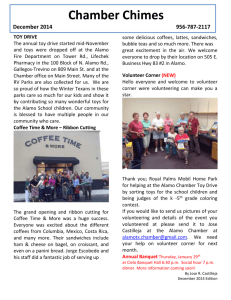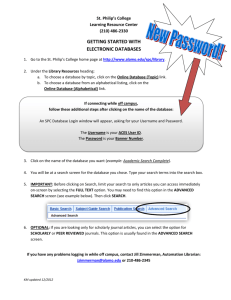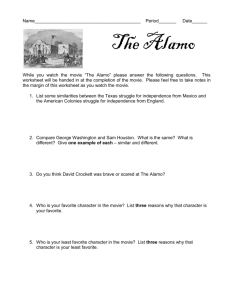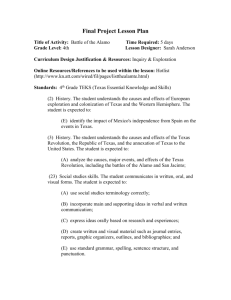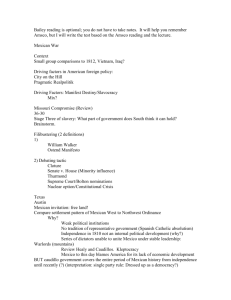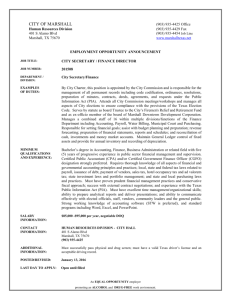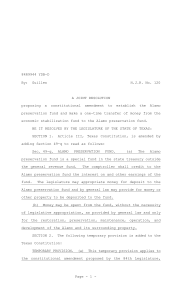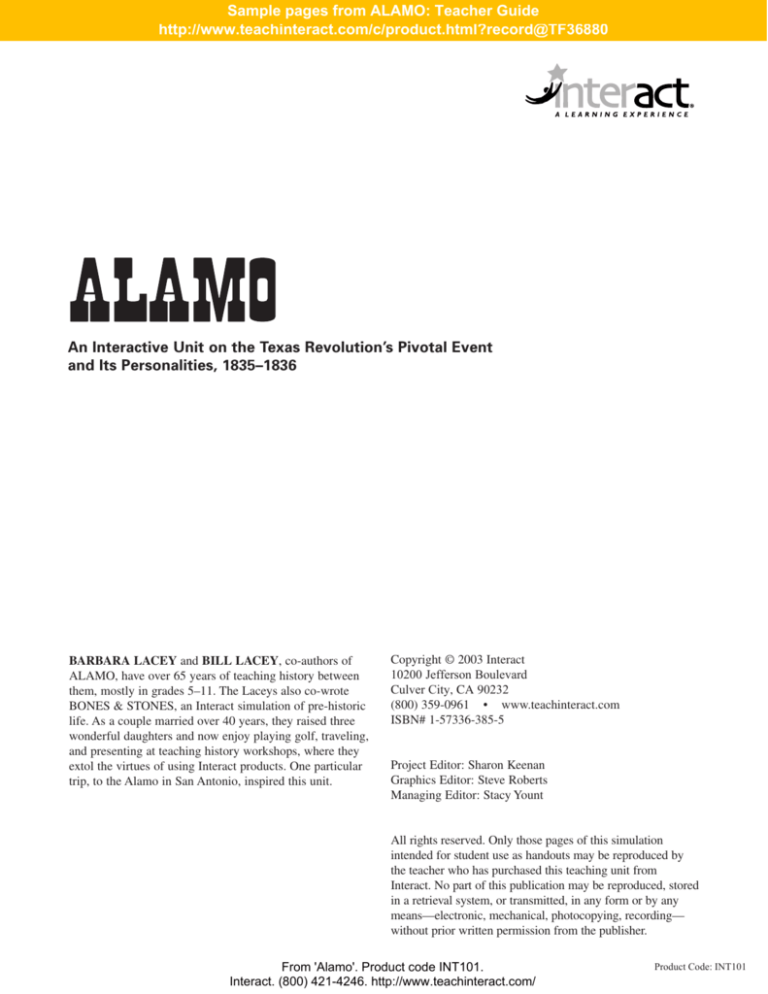
Sample pages from ALAMO: Teacher Guide
http://www.teachinteract.com/c/product.html?record@TF36880
ALAMO
An Interactive Unit on the Texas Revolution’s Pivotal Event
and Its Personalities, 1835–1836
BARBARA LACEY and BILL LACEY, co-authors of
ALAMO, have over 65 years of teaching history between
them, mostly in grades 5–11. The Laceys also co-wrote
BONES & STONES, an Interact simulation of pre-historic
life. As a couple married over 40 years, they raised three
wonderful daughters and now enjoy playing golf, traveling,
and presenting at teaching history workshops, where they
extol the virtues of using Interact products. One particular
trip, to the Alamo in San Antonio, inspired this unit.
Copyright © 2003 Interact
10200 Jefferson Boulevard
Culver City, CA 90232
(800) 359-0961 • www.teachinteract.com
ISBN# 1-57336-385-5
Project Editor: Sharon Keenan
Graphics Editor: Steve Roberts
Managing Editor: Stacy Yount
All rights reserved. Only those pages of this simulation
intended for student use as handouts may be reproduced by
the teacher who has purchased this teaching unit from
Interact. No part of this publication may be reproduced, stored
in a retrieval system, or transmitted, in any form or by any
means—electronic, mechanical, photocopying, recording—
without prior written permission from the publisher.
From 'Alamo'. Product code INT101.
Interact. (800) 421-4246. http://www.teachinteract.com/
Product Code: INT101
Sample pages from ALAMO: Teacher Guide
http://www.teachinteract.com/c/product.html?record@TF36880
The nationwide movement for high standards has not only determined what students
should learn, but also has mandated that students demonstrate what they know.
ALAMO is a standards-based unit addressing numerous History Thinking, U.S.
History, and English Language Arts Standards. The content is the target of most
state frameworks for American History. ALAMO provides many opportunities for
both informal and formal assessment as students explore the events leading up to the
siege and storming of the Alamo, and study the motivations and personalities of both
attackers and defenders. The cooperative problem-solving and decision-making
required in ALAMO also address Applied Learning standards.
National Standards for History
Standards in Historical Thinking
Standard 1: Chronological Thinking
The student is able to:
B. Identify the temporal structure of a historical narrative or story.
E. Interpret data presented in time lines and create time lines by
designating appropriate equidistant intervals of time and recording events
according to the temporal order in which they occurred.
Standard 2: Historical comprehension
The student is able to:
B. Reconstruct the literal meaning of a historical passage by identifying
who was involved, what happened, where it happened, what events led to
these developments, and what consequences or outcomes followed.
D. Differential between historical facts and historical interpretations but
acknowledge that the two are related; that the facts the historian reports are
selected and reflect therefore the historian’s judgment of what is most
significant about the past.
E. Read historical narratives imaginatively, taking into account what the
narrative reveals of the humanity of the individuals and groups involved—
their probable values, outlook, motives, hopes, fears, strengths, and
weaknesses.
F. Appreciate historical perspectives (a) describing the past on its own
terms, through the eyes and experiences of those who were there, as
revealed through their literature, diaries, letters, debates, arts, artifacts,
and the like; (b) considering the historical context in which the event
unfolded—the values, outlook, options, and contingencies of that time and
place; and (c) avoiding “present-mindedness,” judging the past solely in
terms of present-day norms and values.
INTERACT | Order Direct: (800) 359-0961 | © 2003 Interaction Publishers, Inc.
STANDARDS
ALAMO
ALAMO Teacher Guide
Sample pages from ALAMO: Teacher Guide
http://www.teachinteract.com/c/product.html?record@TF36880
S TA N D A R D S
STANDARDS
Standard 3: Historical Analysis and Interpretation
The student engages in historical analysis and interpretation. The student is able to:
B. Consider multiple perspectives of various people in the past by
demonstrating their differing motives, beliefs, interests, hopes, and fears.
C. Analyze cause-and-effect relationships bearing in mind multiple
causation, including (a) the importance of the individual in history; (b) the
influence of ideas, human interests, and beliefs; and (c) the role of chance,
the accidental and the irrational.
J. Hypothesize the influence of the past, including both the limitations and
the opportunities made possible by past decisions.
Standard 4: Historical Research Capabilities
The student conducts historical research. The student is able to:
B. Obtain historical data from a variety of sources including library and
museum collections, historic sites, historical photos, journals, diaries...oral
testimony from living witnesses...censuses, tax records, etc.
National Standards for U. S. History
Era 4: Expansion and Reform (1801–1861)
Standard 1
United States territorial expansion between 1801 and 1861, and how it affected
relations with external powers and Native Americans.
1C. The student understands the ideology of Manifest Destiny, the nation’s
expansion to the Northwest, and the Mexican-American War.
NCTE Standards for the English Language Arts
Standard 4: Students adjust their use of spoken, written, and visual language
(e.g., conventions, style, vocabulary) to communicate with different
audiences for a variety of purposes.
Standard 5: Students employ a wide range of strategies as they write and use
different writing process elements appropriately to communicate with
different audiences for a variety of purposes.
Standard 6: Students apply knowledge of language structure, language
conventions, (e.g., spelling and punctuation), media techniques, figurative
language, and genre to create, critique, and discuss print and non-print
texts.
Standard 7: Students conduct research on issues and interests by generating
ideas and questions, and by posing problems. They gather, evaluate, and
synthesize data from a variety of sources (e.g., print and non-print text,
artifacts, people) to communicate their discoveries in ways that suit their
purpose and audience
ALAMO Teacher Guide
© 2003 Interaction Publishers, Inc. | www.teachinteract.com | INTERACT
Sample pages from ALAMO: Teacher Guide
http://www.teachinteract.com/c/product.html?record@TF36880
Standard 8: Students use a variety of technological and informational resources
(e.g., libraries, databases, computer networks, video) to gather and
synthesize information and to create and communicate knowledge.
California Applied Learning Standards
Standard 6. Students will understand how to apply communication skills and
techniques. Students will demonstrate ability to communicate orally and
in writing.
Standard 8. Students will understand the importance of teamwork. Students will
work on teams to achieve project objectives
INTERACT | Order Direct: (800) 359-0961 | © 2003 Interaction Publishers, Inc.
STANDARDS
S TA N D A R D S
ALAMO Teacher Guide
Sample pages from ALAMO: Teacher Guide
http://www.teachinteract.com/c/product.html?record@TF36880
TA B L E O F C O N T E N T S
Purpose . . . . . . . . . . . . . . . . . . . . . . . . . . . . . . . . . . . . . . . . . . . . . . . . . . . 1
Setup Directions . . . . . . . . . . . . . . . . . . . . . . . . . . . . . . . . . . . . . . . . . . . . . 3
Assessments . . . . . . . . . . . . . . . . . . . . . . . . . . . . . . . . . . . . . . . . . . . . . . . 11
The Jigsaw Classroom . . . . . . . . . . . . . . . . . . . . . . . . . . . . . . . . . . . . . . . 13
Resources/Bibliography . . . . . . . . . . . . . . . . . . . . . . . . . . . . . . . . . . . . . . 14
Unit Time Chart . . . . . . . . . . . . . . . . . . . . . . . . . . . . . . . . . . . . . . . . . . . 17
Daily Directions . . . . . . . . . . . . . . . . . . . . . . . . . . . . . . . . . . . . . . . . . . . . 19
Teacher Reference
Alamo Roster . . . . . . . . . . . . . . . . . . . . . . . . . . . . . . . . . . . . . . . . . . . 45
Answer Key: Texas Map . . . . . . . . . . . . . . . . . . . . . . . . . . . . . . . . . . 46
Observation Log . . . . . . . . . . . . . . . . . . . . . . . . . . . . . . . . . . . . . . . . . 47
Answer Key: Bombardment! Study Guide . . . . . . . . . . . . . . . . . . . . 48
Bombardment! Questions/Answers . . . . . . . . . . . . . . . . . . . . . . . . . . 49
Bombardment! Key Targets (Mexican) . . . . . . . . . . . . . . . . . . . . . . . 52
Bombardment! Key Targets (Texian) . . . . . . . . . . . . . . . . . . . . . . . . 53
Answer Key: The Two Sides . . . . . . . . . . . . . . . . . . . . . . . . . . . . . . . 54
Answer Key: Exam . . . . . . . . . . . . . . . . . . . . . . . . . . . . . . . . . . . . . . 55
About Tex-Mex Cuisine . . . . . . . . . . . . . . . . . . . . . . . . . . . . . . . . . . . 56
Reproducible Masters
AMPs SCORE SHEET . . . . . . . . . . . . . . . . . . . . . . . . . . . . . . . . . . . . 57
WHAT IS THE ALAMO? . . . . . . . . . . . . . . . . . . . . . . . . . . . . . . . . . . 58
COOPERATIVE GROUP WORK RUBRIC . . . . . . . . . . . . . . . . . . . . 59
EXTENSIONS . . . . . . . . . . . . . . . . . . . . . . . . . . . . . . . . . . . . . . . . . . 60
CONTENT RUBRIC . . . . . . . . . . . . . . . . . . . . . . . . . . . . . . . . . . . . . . 61
1836: A PERSPECTIVE . . . . . . . . . . . . . . . . . . . . . . . . . . . . . . . . . . . 62
ALAMO “SHAPE” BOOKLET (Research Project) . . . . . . . . . . . . . . . 63
THE ALAMO: An Overview . . . . . . . . . . . . . . . . . . . . . . . . . . . . . . . . 64
TEXAS TIME LINE . . . . . . . . . . . . . . . . . . . . . . . . . . . . . . . . . . . . . . 72
CONTENTS
Overview . . . . . . . . . . . . . . . . . . . . . . . . . . . . . . . . . . . . . . . . . . . . . . . . . . 2
THE ALAMO AT A GLANCE . . . . . . . . . . . . . . . . . . . . . . . . . . . . . . 73
INTERACT | Order Direct: (800) 359-0961 | © 2003 Interaction Publishers, Inc.
ALAMO Teacher Guide
Sample pages from ALAMO: Teacher Guide
http://www.teachinteract.com/c/product.html?record@TF36880
TA B L E O F C O N T E N T S
PARALLELS: Thermopylae and the Alamo . . . . . . . . . . . . . . . . . . . . . 74
CONTENTS
AN ALAMO DIALOGUE . . . . . . . . . . . . . . . . . . . . . . . . . . . . . . . . . . 75
ALAMO Teacher Guide
ALAMO POETRY . . . . . . . . . . . . . . . . . . . . . . . . . . . . . . . . . . . . . . . 80
ALAMO DEFENDERS: Why They Stayed to Fight . . . . . . . . . . . . . . 82
TEXAS STAR PROFILES (#1–#7) . . . . . . . . . . . . . . . . . . . . . . . . . . . 84
TEXAS STAR REPORT . . . . . . . . . . . . . . . . . . . . . . . . . . . . . . . . . . . 98
PRESENTATION RUBRIC . . . . . . . . . . . . . . . . . . . . . . . . . . . . . . . . 100
TEXAS STAR JIGSAW NOTES . . . . . . . . . . . . . . . . . . . . . . . . . . . . 101
PROJECT SELF-EVALUATION . . . . . . . . . . . . . . . . . . . . . . . . . . . . 102
OTHER NOTABLES IN THE ALAMO STORY . . . . . . . . . . . . . . . . 103
FROZEN MOMENTS (#1–#7) . . . . . . . . . . . . . . . . . . . . . . . . . . . . . 105
FROZEN MOMENTS NARRATION . . . . . . . . . . . . . . . . . . . . . . . . 119
TRAVIS’S PLEA FOR REINFORCEMENTS . . . . . . . . . . . . . . . . . . 126
BOMBARDMENT! STUDY GUIDE . . . . . . . . . . . . . . . . . . . . . . . . 127
BOMBARDMENT! COMPETITIVE REVIEW . . . . . . . . . . . . . . . . . 129
BOMBARDMENT! SCORE SHEET . . . . . . . . . . . . . . . . . . . . . . . . . 130
BOMBARDMENT! THE REAL SIEGE . . . . . . . . . . . . . . . . . . . . . . 131
BOMBARDMENT! STORMING THE ALAMO . . . . . . . . . . . . . . . . 132
BOMBARDMENT! SAN ANTONIO DE BEXAR . . . . . . . . . . . . . . 133
EXAM . . . . . . . . . . . . . . . . . . . . . . . . . . . . . . . . . . . . . . . . . . . . . . . . 134
© 2003 Interaction Publishers, Inc. | www.teachinteract.com | INTERACT
Sample pages from ALAMO: Teacher Guide
http://www.teachinteract.com/c/product.html?record@TF36880
PURPOSE
Knowledge
• Learn the essential history of the Texas Revolution
• Place the events in Texas in the context of America’s western expansion in
the nineteenth century
• Learn common myths about the Alamo and discard or accept each in light
of historical analysis and fact
• Become familiar with several history-makers who played key roles in the
Texas Revolution
• Learn important geography of the region and how each site shaped events
relating to the Texas Revolution
• Learn and make use of key historical terms and names relating to the Texas
Revolution
Skills
• Practice effective group discussion and decision-making skills
• Utilize oral participation skills in front of small and large groups
• Prepare and orally present information in role-playing situations
• Take and organize notes during oral presentations
• Analyze and evaluate information presented by peers
• Read for understanding, research, and write to reflect knowledge
Attitudes
• Realize that warfare, especially a war for independence, is often brutal,
inglorious, and uncompromising
• Honor the brave men on both sides at the Alamo, but especially the
Texian garrison
• Understand that the martyrdom of the Alamo defenders had a huge impact
on subsequent events, including the pivotal Battle of San Jacinto and, a
decade later, the war with Mexico
• Understand that taking a defiant stand, especially a military one, involves
accepting responsibility for one’s actions and beliefs, and can lead to capture,
imprisonment, or death
• Appreciate the dynamics of group interaction and cooperation
• Understand that hard work usually produces better results
• Learn that teamwork most often produces a better product and does so
more easily than individual efforts
INTERACT | Order Direct: (800) 359-0961 | © 2003 Interaction Publishers, Inc.
PURPOSE
In ALAMO students learn first hand the causes, course, and results of the
Texas Revolution of the 1830s. Of course, the siege and battle of the Alamo is
the keystone to all of the revolution’s events and is the heart of this unit.
While participating in ALAMO, students gain valuable insights into Texas
history and sharpen critical thinking skills. Specifically, your students
experience the following:
ALAMO Teacher Guide 1
Sample pages from ALAMO: Teacher Guide
http://www.teachinteract.com/c/product.html?record@TF36880
OVERVIEW
OVERVIEW
When visitors come to San Antonio to view the church and grounds, it is akin to
a pilgrimage, an acknowledgement that the Alamo is indeed an awesome shrine
for the men who defended its walls for 13 days in 1836, against a vastly superior
Mexican army. Entering the cool, quiet interior of the mission itself, visiting
pilgrims remove their hats and caps and read a sign on the door:
Be silent, friend
Here heroes died
To blaze a trail
For other men
Several have written that there are two Alamos: one is the Alamo in historical
fact and the other the myriad myths we have created about it. While we like to
think the Alamo of history is the version we Americans embrace, the Alamo of
myth is more embedded into our collective imaginations and culture. Both levels
have captured Americans—and especially Texans—for over 160 years.
Students begin their study of the Alamo by reading a comprehensive essay of
events prior to, during, and after the destruction of the Alamo garrison. They then
break into contingents to become experts on one of seven Texas Stars. Armed
with their newly gained knowledge, they jigsaw into different groups and
role-play their Texas Star to teach others about this individual. Students take
notes on each presentation. They then return to their original contingents to
discuss lesser-known individuals significant in the history of the Alamo. They
create a butcher paper tapestry to present to the rest of the class.
The next major activity again involves role-playing. Within their contingents,
students portray real characters from the Alamo story in episodes depicted in
tableaus called Frozen Moments. The teacher stops and starts action by touching,
and thus “unfreezing” the characters in a scene. These characters then respond to
questions as the episode is played out.
The unit also includes map work, a comparison of the two sides, an explanatory
Alamo dialogue, a poetry assignment, a research project, and an exciting
competitive review simulating an exchange of artillery fire by both sides.
Differentiation
Like all INTERACT units, ALAMO provides differentiated instruction through
its various learning opportunities. Students learn and experience the knowledge,
skills, and attitudes through all domains of language (reading, writing, speaking,
listening). The academic and kinesthetic activities appeal to a variety of learning
aptitudes. Adjust the choice of activities to best fit your students and encourage
their strengths.
2 ALAMO Teacher Guide
© 2003 Interaction Publishers, Inc. | www.teachinteract.com | INTERACT
Sample pages from ALAMO: Teacher Guide
http://www.teachinteract.com/c/product.html?record@TF36880
D A I LY D I R E C T I O N S
DAY 1
Day 1
Objectives
• Introduce unit
• Establish contingents/make folders
Materials
• Student Guide — class set
• WHAT IS THE ALAMO? — transparency
• COOPERATIVE GROUP WORK RUBRIC — one per
contingent + one to post (optional)
• EXTENSIONS — class set (optional)
• CONTENT RUBRIC — class set + one to post (optional)
• 1836: A PERSPECTIVE — transparency
• ALAMO “SHAPE” BOOKLET — class set (optional)
• Lined paper (8.5" x 11") — class set
• Pocket folders — one per contingent
Teacher Reference
• Alamo Roster — one
Preparation
1. Decide student contingent assignments and complete an
Alamo Roster.
2. Decide whether your students will complete an EXTENSION
and/or ALAMO “SHAPE” BOOKLET research activity.
Procedure
1. Have students take out lined paper. As a motivator ask them to
number 1 through 7 on the paper. Then ask them to answer these
questions:
1. What is the Alamo?
2. Where is the Alamo?
3. What two forces fought at the Alamo?
4. Who won the battle?
5. What famous persons died at the Alamo?
6. Approximately when did the battle occur? (month/year)
7. Why should we spend the next ___ days involved in the
story of the Alamo?
2. When students have finished, illuminate the WHAT IS THE
ALAMO? transparency and discuss their responses to the seven
questions. Add detail and color as appropriate.
INTERACT | Order Direct: (800) 359-0961 | © 2003 Interaction Publishers, Inc.
This is an important day because
students will get the “feel” and
overview of the unit, if not
necessarily the historical content.
Option: Show the last five minutes
of the Walt Disney film, Davy
Crockett: King of the Wild Frontier
(see Resources/Bibliography on
page 15). Have a lively discussion
about the controversy surrounding
Crockett’s death and some Alamo
“myths” that are perpetuated in
our popular culture.
ALAMO Teacher Guide 19
Sample pages from ALAMO: Teacher Guide
http://www.teachinteract.com/c/product.html?record@TF36880
D A I LY D I R E C T I O N S
DAY 1
3. Distribute the Student Guides and read the page 1. Tell students the
scope and approximate sequence of the unit, what they will be
doing and for how long. Turn to page 2. Read and explain how
students will work in contingents. Distribute and review the
COOPERATIVE GROUP WORK RUBRIC. (If you will use the
Alamo Mission Points (AMPs) competition, introduce how this
will work in your classroom.)
4. Option: Distribute the EXTENSIONS information and review.
Answer any questions. Distribute the CONTENT RUBRIC and go
over your expectations. If you are using competition and points,
explain how Extension projects enable students to earn extra
AMPs.
5. Illuminate the 1836: A PERSPECTIVE transparency and go
over its interesting contents. Note that it reflects on the year
1836, as well as past and future events.
6. Move students into their contingents. Have them select a
“colonel” to lead them for today. The title is mostly honorary
and ceremonial, yet, expect leadership from the colonels.
Explain if, how, and how often students will change role
responsibilities.
7. If time, distribute contingent folders and have students decorate
with a flag and contingent motto. Instruct students to keep all
handouts and other materials in these folders throughout the
unit.
8. Distribute the ALAMO “SHAPE” BOOKLET information.
Introduce it and go over the requirements and establish a due
date. If not already done, distribute the CONTENT RUBRIC and
go over your expectations.
20 ALAMO Teacher Guide
© 2003 Interaction Publishers, Inc. | www.teachinteract.com | INTERACT

